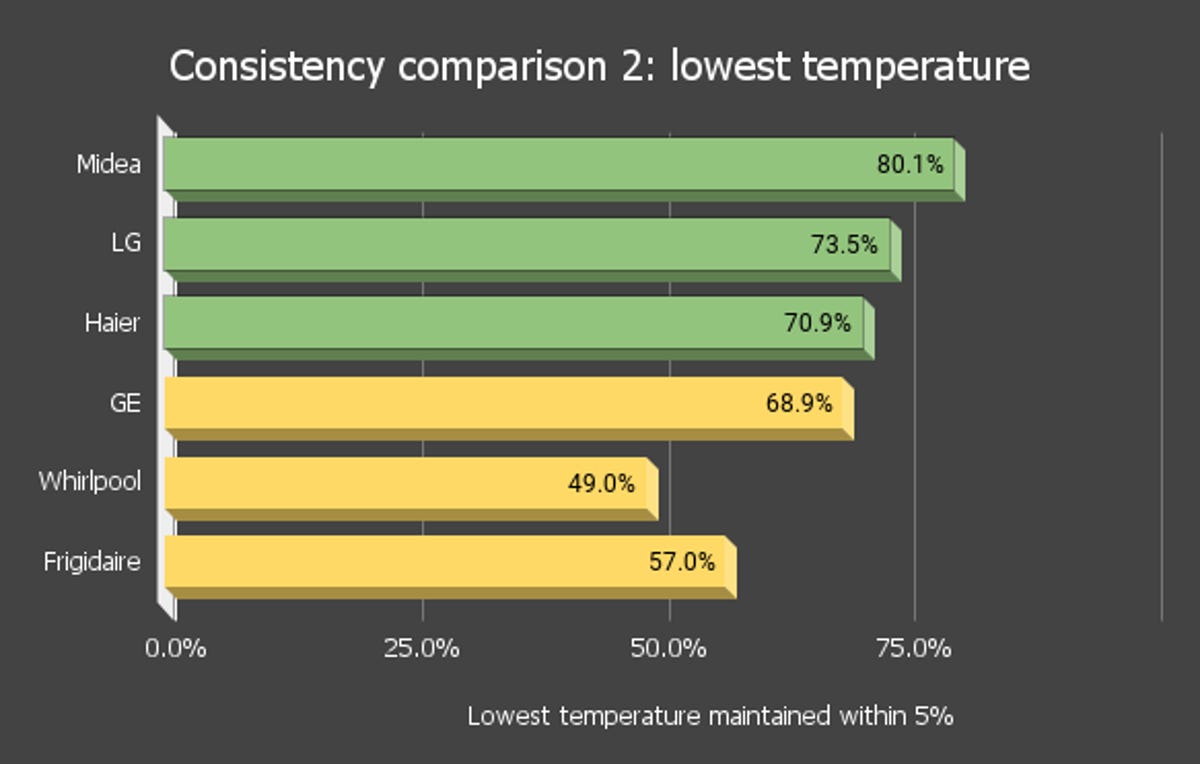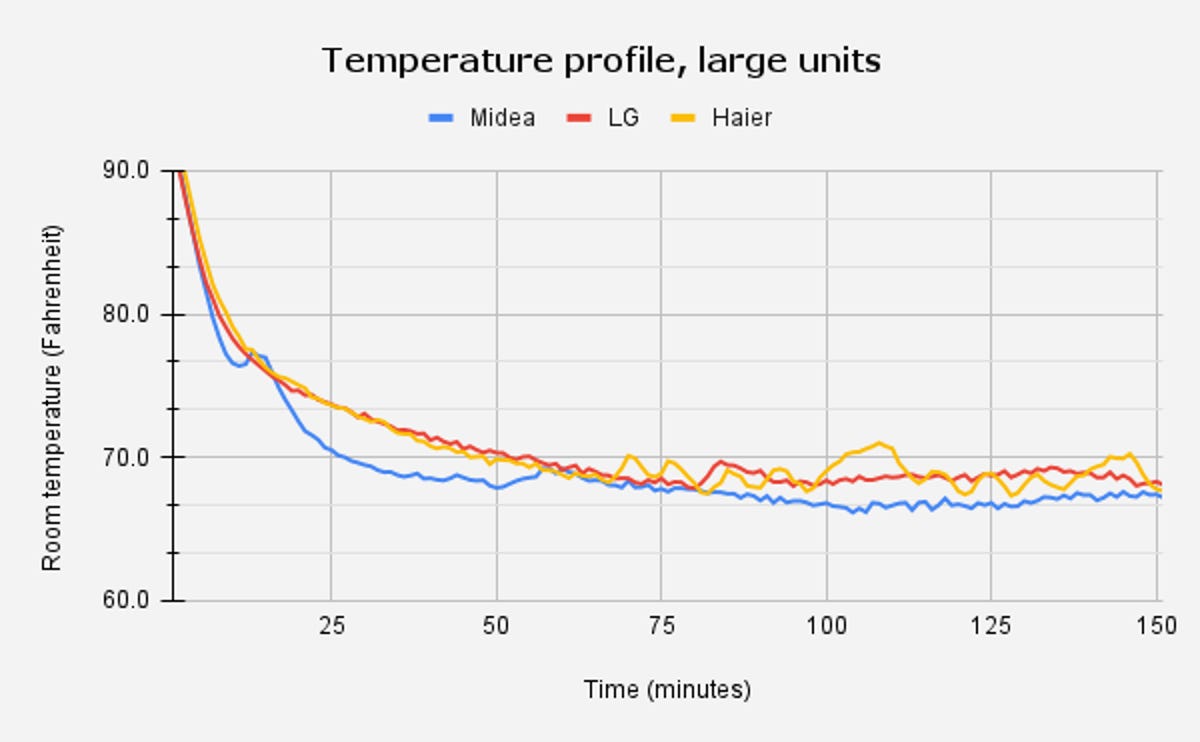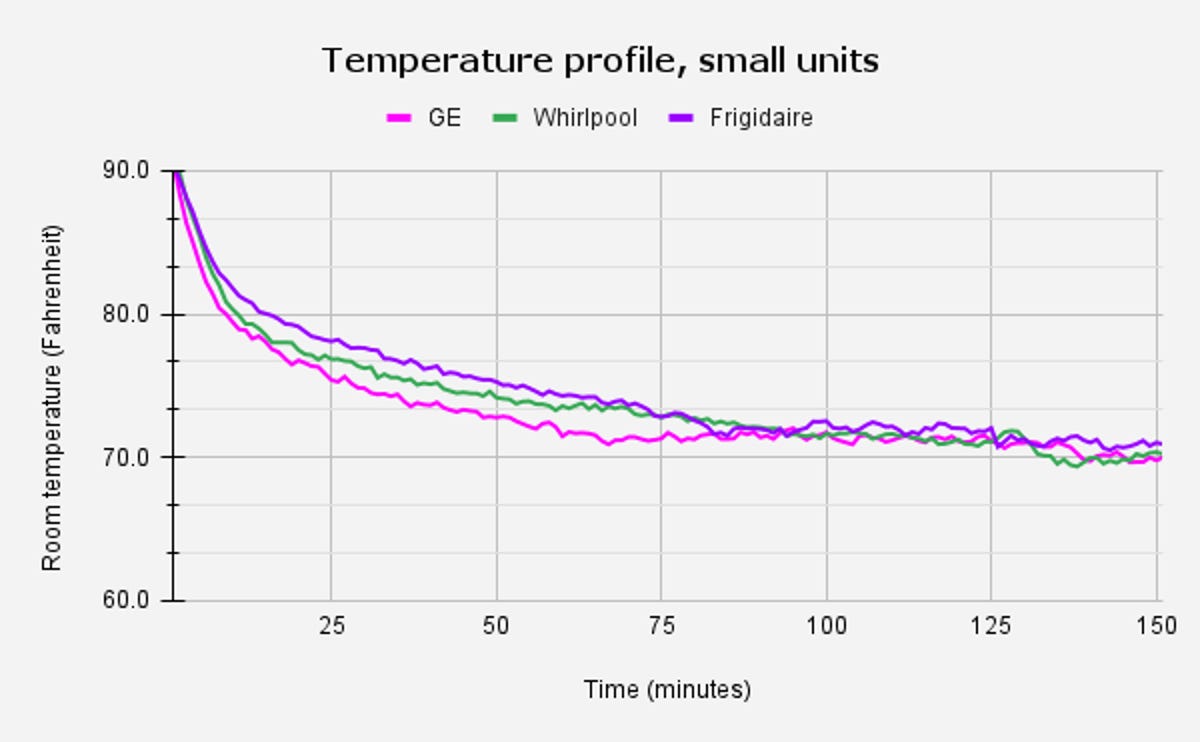
Best Portable Air Conditioners of 2022
Unlike a heavy and more permanent window air conditioner, portable AC units are designed to be easily moved between rooms. With the added mobility, you can stay cool as you move between different spaces throughout the day. Most portable air conditioners come equipped with wheels, which makes them easy to move from room to room, and while all units will help you beat the heat, there are a few different options depending on the size of the room and the specific features you may need.
We tested six portable AC units, ranging in price from $349 to $699, to see which ones stood out the most and what array of options they offer so you get a good value for your money.
Read more: Window Air Conditioners vs. Portable Air Conditioners: Find Out Which One Is Best for You
If you're searching for a portable air conditioner to cover small to medium spaces, look no further than the GE APCD08JALW. Designed to cool up to a 350-square-foot room, the APCD08JALW is an excellent choice for anyone looking for an AC unit that can handle smaller bedrooms, offices and other living spaces with ease.
It performed admirably in our testing, maintaining its lowest temperature nearly 70% of the time. The other small units we tested -- the Frigidaire FHPC082AC1 and the Whirlpool WHAP131BWC -- weren't able to keep up with the GE unit in this test. It also did well in the second test, where we see how consistently the unit maintains a set temperature of 68 degrees Fahrenheit. Again the GE APCD08JALW took first place. We discuss our test procedures in depth later in this article if you want to learn more about the process.
GE's APCD08JALW has a cooling capacity of 8,500 British thermal units and costs $479. Check out the chart in the section below for a more in-depth look at how its features and specs compare with those of the other units we tested.
Overall, this GE portable AC unit is a great option if you're looking for a smaller air conditioner at a reasonable price. Bonus: At 62 pounds, this AC unit is one of the lightest and therefore one of the most easily portable units of the bunch. That makes it a solid choice if you plan to regularly move it between rooms. Plus, its slightly smaller dimensions would suit apartment living or work well for anyone otherwise limited in space.
Not only did the Midea MAP14HS1TBL excel in performance compared with the other larger portable air conditioners we tested, it also has a lot of features and speciality options. At $699, this unit isn't cheap, but it's a well-rounded luxury AC unit with everything you need -- and then some.
To start, the MAP14HS1TBL has the highest cooling capacity of any other model we tested. Those 12,000 Btu come in handy for cooling larger spaces up to 550 square feet and it showed in the performance. The Midea model beat out the two other larger AC units in this list, the Haier QPWA14YZMW and the LG LP1419IVSM, in both of our performance tests.
This model also comes with a standard remote control and has sleep mode, timer and dehumidifier functions, as well as an app and support for Alexa and Google Assistant voice commands.
Overall, the Midea MAP14HS1TBL has all the premium features and options you'd expect for $699. Throw in its stellar performance and this unit is our top pick to cool larger spaces. Keep in mind that this air conditioner was also the heaviest unit we tested at 77 pounds, but, like the rest, it comes with wheels for easy maneuvering.
The Haier QPWA14YZMW is an excellent midpoint between the GE and Midea AC units. At around $590, its price sits in the middle of the best small and best high-end air conditioners, yet it offers similar specs and performance to the Midea model, just without some of the advanced features.
Specifically, this Haier AC unit has a 9,700-Btu cooling capacity and can cool up to a 550-square-foot room. While its cooling capacity is lower than the 12,000-Btu Midea air conditioner, the Haier unit held its own during testing. It managed to maintain a 68-degree set temperature over 75% of its running time (compared with the Midea's 85%). It also maintained its lowest temperature 70.9% of its running time, after the Midea's 80.1% and the Whirlpool's 73.5%.
As far as features go, this unit has a remote control and timer and dehumidifier functions. It also has an app, but you won't have support for voice assistants like Alexa or Google Assistant.
Overall this Haier portable air conditioner performed well, but costs less and has fewer features than the Midea AC unit. If you don't want all the extras of the Midea, the Haier QPWA14YZMW is a solid alternative at a great value. If you don't need a portable air conditioner that can cool up to 550 square feet, look instead to our favorite smaller unit, the GE APCD08JALW.
The contenders
We tested six portable air conditioners for this best list: the Frigidaire FHPC082AC1, the GE APCD08JALW, the Haier QPWA14YZMW, the LG LP1419IVSM, the Midea MAP14HS1TBL and the Whirlpool WHAP131BWC. In the chart below, you can get an overview of each unit and how they compare in terms of pricing, specs and features.
Portable air conditioners
| | Frigidaire FHPC082AC1 | GE APCD08JALW | Haier QPWA14YZMW | LG LP1419IVSM | Midea MAP14HS1TBL | Whirlpool WHAP131BWC |
|---|---|---|---|---|---|---|
| Price | $349 | $579 | $590 | $699 | $699 | $526 |
| Area it covers (in square feet) | 350 | 350 | 550 | 500 | 550 | 350 |
| Btu | 5,500 | 8,500 | 9,700 | 10,000 | 12,000 | 8,000 |
| Weight (in pounds) | 50 | 62 | 71 | 71 | 77 | 75 |
| Dimensions (HxWxD, in inches) | 26.8 x 12.17 x 13.78 | 28.9 x 16.7 x 14.7 | 32 x 18.5 x 15.35 | 32.36 x 22.13 x 19.84 | 34.48 x 19.53 x 16.73 | 27.9 x 18.7 x 15.16 |
| Special features | Remote control, timer, dehumidifier function, sleep mode | Remote control, timer, dehumidifier function | Remote control, timer, app, dehumidifier function | Remote control, timer, app, dehumidifier function | Remote control, timer, app, supports Alexa and Google Assistant, dehumidifier function, sleep mode | Remote control, timer, sleep mode |
At a glance, you can see we tested some units with similar specs, while also covering a wide range of options. Not only do the prices vary from $349 to $699, but half of the units are designed to cool smaller 350-square-foot rooms, while the rest can handle larger spaces up to 500 or 550 square feet. They also vary in terms of Btu, which range in the units we tested from 5,500 to 12,000 Btu.
It's worth noting here that there are currently two different standards for determining Btu capacity: the American Society of Heating, Refrigerating and Air-Conditioning Engineers' Btu rating and the Department of Energy's Seasonally Adjusted Cooling Capacity Btu rating. For that reason, many manufacturer sites list both the ASHRAE and the SACC ratings in their specs.
For example, the Frigidaire FHPC082AC1 we tested has an ASHRAE capacity of 8,000 Btu, while the DOE's SACC rating for the same unit is 5,500 Btu. The SACC standard was developed more recently and is being broadly adopted across manufacturers, so we use the SACC Btu capacity as the default standard anywhere we reference Btu capacity in this list. Still have questions about this? Learn more about the SACC standard here. (PDF)
How we test
To test portable air conditioners, we heat a climate-controlled room to 92 degrees. After the room reaches 92 degrees, we turn off the heat and turn on the portable AC unit to cool mode, with a medium fan speed and a set temperature of 68 degrees. We run the unit for 2 hours and 30 minutes and repeat the same test twice per AC unit. We then use the data collected during the tests to measure two things:
- How consistently the portable air conditioner kept the room within 5% of 68 degrees
- How consistently it kept the room within 5% of the AC unit's individual lowest temperature
Once we have this information, we compare the results across the units to see which ones maintained the set temperature for the longest period of time. We also look at which units maintained their individual lowest temperature for the longest time. We did this so that if a unit didn't reach 68 degrees in the allotted time, we were still able to track how consistently it maintained the lowest temperature it did achieve. The higher the percentage, the better the unit performed.
When looking at performance, it's important to note that the units we tested don't have identical specs, so direct performance comparisons are not the only thing we consider when arriving at our list of best portable air conditioners. We also look at a unit's features and other options in reference to its price and specifications to determine its overall value.
We also don't draw direct performance comparisons when looking at units of vastly different sizes and capabilities, say, the 12,000-Btu Midea MAP14HS1TBL versus the 5,500-Btu Frigidaire FHPC082AC1. For this reason, we compared performance results in two groups based on coverage area. Specifically, we compared the Frigidaire, Whirlpool and GE models (which all have coverage areas of up to 350 square feet) against one another and the Haier, LG and Midea models (which have 500-to-550-square-foot coverage areas) against one another.
Performance
Delving a little more into performance, you can see how long all six portable air conditioners maintained a temperature set point of 68 degrees. Again, because we aren't comparing the larger units (the Midea, LG and Haier models) directly with the smaller ones (the GE, Whirlpool and Frigidaire), we've displayed the larger units at the top of the chart and the smaller units at the bottom, and used different colors to help you differentiate between them more easily.
The Midea air conditioner performed the best, maintaining the 68-degree set point for 85.4% of its runtime. The Haier model came in second with 75.5% and the LG model in third with 74.2%. For the smaller units, the GE air conditioner came in first at 39.7%, followed by the Whirlpool model at 25.2% and the Frigidaire unit at 15.2%.
For the second test, we looked at how consistently the unit maintained its lowest temperature. Again, we divided the results in the chart below, with the larger units in green on the top and the smaller units in yellow on the bottom.

The Midea air conditioner once again outperformed the other large units by maintaining its lowest temperature for 80.1% of its runtime. The LG model came in second at 73.5% and the Haier model in a close third with 70.9%. For the smaller units, the GE model performed extremely well, only closely trailing the larger Haier air conditioner at 68.9%. The Frigidaire model came next at 57% and the Whirlpool model came in third at 49%.
Overall the powerful Midea model knocked out the other larger units by coming in first in both tests. The smaller Whirlpool model outperformed its competition by maintaining the 68-degree set point longer in the first test, but the smaller GE unit dominated in the second test, maintaining its lowest temperature for longer than either Whirlpool or Frigidaire.
In addition, we made charts to track the temperature changes of each unit over time. The chart below focuses only on the larger units we tested. The Midea unit's temperature dropped more quickly than the others and maintained the lower temperature for most of its run, whereas the LG and Haier units performed similarly throughout.

We also tracked the temperature changes for the smaller units throughout testing. The GE unit's temperature dropped more quickly than the others, followed by Whirlpool, then Frigidaire, but they all ended up reaching and maintaining a similar temperature in the second half of their runs.

Portable air conditioner FAQs
Do portable ACs have to vent through the windows?
Yes. In order to have optimal performance for a portable air conditioner, you need to set up the included hose or hoses to vent outside. Without this step, the hot air and condensation won't have anywhere to go and could hurt the unit's ability to cool a room effectively.
How do portable AC units work?
We go into more detail in our portable air conditioner buying guide, but they pull in air from your house, cool it and recirculate it back into the room or space of your choosing. Portable AC units plug into a wall outlet and feature one or two hoses. One-hose units vent exhaust out of the house. Two-hose units use one hose to vent the exhaust and the other to bring air in from outside.
What portable AC brand is best?
That depends. First consider your needs: What size room (or rooms) do you plan to cool? What is your budget? Are there any special features that you particularly want, like a remote control or a dehumidifier function?
Based on how you answer the above questions, you'll be able to narrow down your options a bit more. What might be the best portable AC unit or brand for one person might not be the same for someone else. For this reason, we provide more than one portable air conditioner recommendation above.
Source
Tags:
- Best Portable Air Conditioners Of 2022 Standard
- Best Portable Air Conditioners Of 2022 Midterm
- Best Portable Air Conditioners Of 2022 Federal Holidays
- Best Portable Air Conditioners Of 2022 Election
- Best Portable Air Conditioners Of 202 2 Ford
- Best Portable Air Conditioners Without Hose
- 5 Best Portable Air Conditioners
- Best Portable Air Compressor For Car Tires
- Best Portable Air Compressor
- Best Portable Heater
- Best Portable Air Compressor








